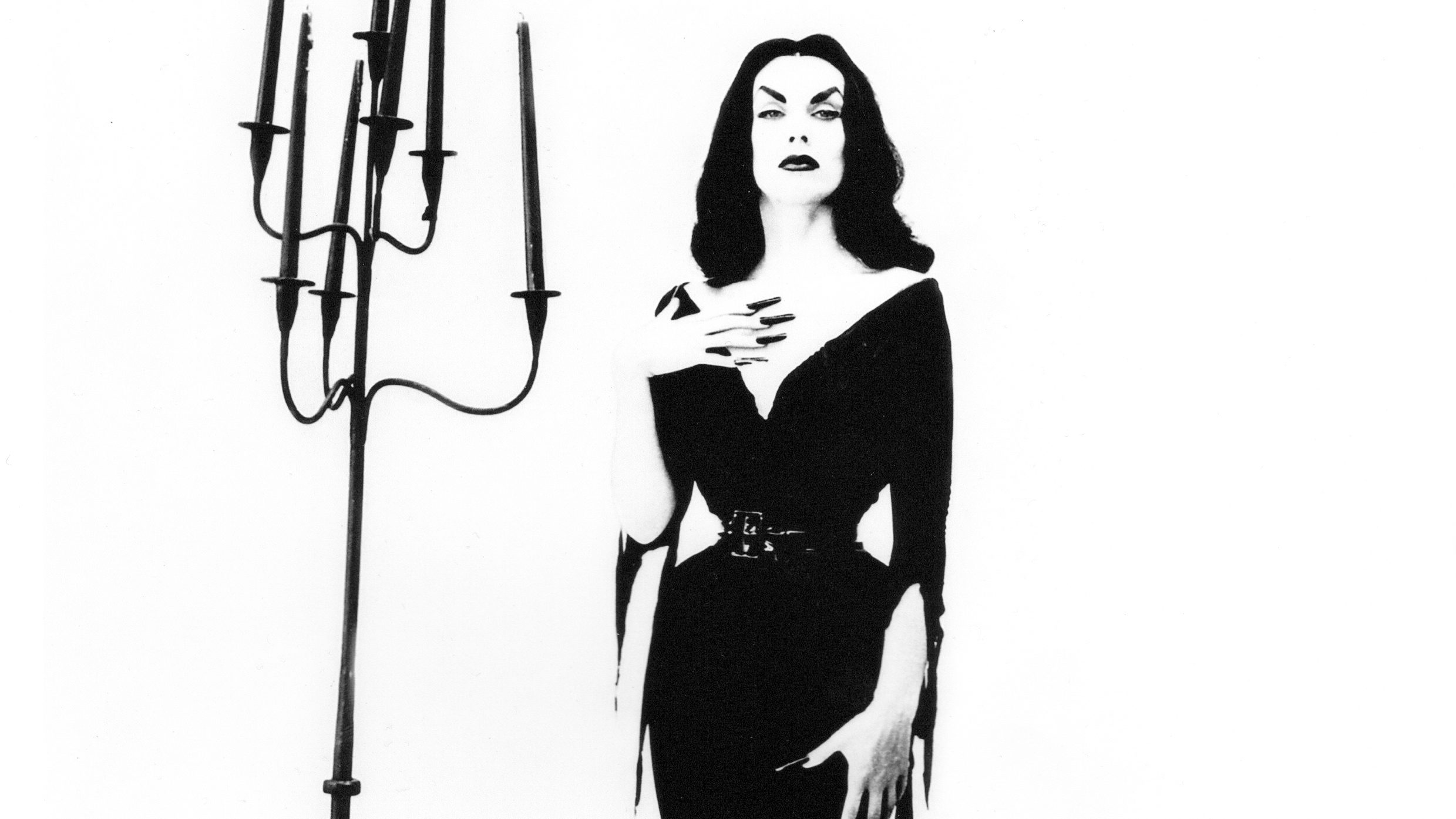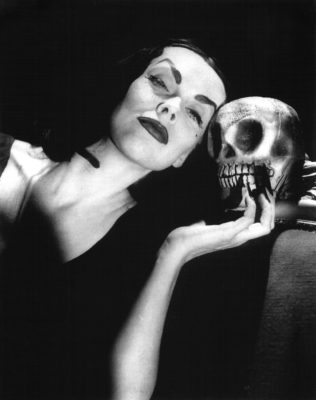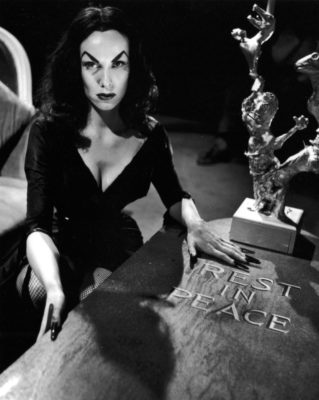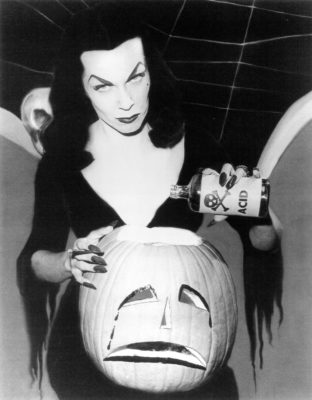
The First Female Horror Host: A History of Vampira by Ashes Fallen
Music Interviews
Maila Nurmi was an iconic American actress who created the campy character of Vampira in the 1950s. When gothic-rock band Ashes Fallen produced the music video for their song “Vampira – The Ballad of Maila,” featuring photos and videos of the glamorous horror host, bandmates James and Michelle Perry wondered about who owns the rights to Vampira’s likeness. Michelle was tenacious in her hunt and discovered Nurmi’s niece, Sandra Niemi, who authored the book Glamour Ghoul: The Passions and the Pain of the Real Vampira, Maila Nurmi about her aunt’s incredible life. SLUG had the opportunity to chat with Ashes Fallen about what they discovered about Vampira’s legendary life as the world’s first female horror host.

The two started talking while Ashes Fallen was touring in Seattle and Portland in March 2022. Niemi arrived with a stack of folders containing Nurmi’s belongings, which she gave to Michelle. These are historic Hollywood artifacts, so it is easy to understand their surprise when the art, photos and personal mementos were given away on the first encounter. Michelle volunteered to help with the archives to preserve the story of Nurmi’s life. James joined Michelle and the two of them spent a week in Salem, Oregon to begin the process of sifting through the famous star’s belongings. They discovered a treasure trove of stories from her life, recounted here to SLUG Magazine.
Nurmi loved cartoons like any other child, but it was characters like the wicked queen Grimhilde in Disney’s Snow White and the Seven Dwarfs that grabbed her attention the most. She also liked the 1934 comic strip Terry and the Pirates because of the Dragon Lady—a villain with dark hair and arched eyebrows. These characters were strong and fearless, but they were also beautiful. Nurmi’s family ended up moving to Astoria, Oregon, which left Nurmi without much of a future outside of working in a fish cannery. She dreamed of a life in the limelight, so she moved to Hollywood in 1940.
Working as a chorus line member, coat check and cigarette vendor became Nurmi’s main source of income, but she got tired of this work and later became a pin–up model. This work attracted the eye of Dean Riesner of Dirty Harry, and the two had a common-law marriage, although their relationship grew cold as Riesner was always working so much. Nurmi was trying to salvage the relationship when she saw bondage material in Bizarre Magazine, an underground fetish publication of the time. Nurmi thought she would try to spruce things up and wasted no time gathering fishnets, corsets and other accessories. When she put them on, she felt not only sexy and sensual, but powerful.

This style and ideology carried through to her personal life, outside of the privacy of her bedroom. Her unique style got her noticed in Hollywood, and she was invited to the “Bal Caribe,” an annual high society event that included a costume contest. She dressed as a sexy Morticia Addams and won, departing the ball early just like Cinderella while leaving everyone wanting more, including a producer from KABC-TV in Los Angeles. Luckily, Nurmi was found through her connection to Riesner and added bondage to her signature look as well as a long cigarette holder and spiked heels. Nurmi called it adding “sex and death” to the Addams character, and Riesner created the name “Vampira.” The producers accepted the look and created The Vampira Show, which aired for close to a year from 1954–1955 and was revived on KHJ-TV in 1956.
The show was eventually stopped because the TV station wanted to buy the rights to Vampira, which Nurmi did not allow as she wanted to remain in control of her creation. She was paid $75 per week, and supplied all materials for the character—expenses such as makeup, nails, hair and costumes quickly added up. Nurmi struggled with money, leading to a deep depression as she withdrew from society. She fought suicidal thoughts with spite, and one of the ways she did this was by shaving her head. Some people thought this was just a part of her punk-rock style, but it was a form of expressing her sadness and grief. She never gave up.
Most media had a much smaller platform back in the 1950s, but tabloid magazines and television censorship through government regulations were just as damaging as they are today. This made things difficult for the stars of Hollywood. In Nurmi’s case, a more conservative dress made the show less appealing for her. There was also the rumor that James Dean died in a car crash due to a hex that she had placed on him, which stems from a photoshoot of Nurmi at Woodlawn Cemetery where she had written “wish you were here” on the back of one her photographs near an open grave. After Dean died, the photograph emerged and Dean’s fans started a “witch hunt” slander campaign against Nurmi. To this day, many still think she may have been a witch, though there has never been any evidence that she practiced witchcraft.

For the rest of the 1950s, Nurmi created B-movies with other actors that had fallen from A-list celebrity status. One of these movies was the Ed Wood creation Plan 9 From Outer Space, which became a cult classic and launched Nurmi into horror stardom. By the 1980s, Vampira was still in the public eye. Her iconic look gained notoriety and fame from The Misfits, who wrote a song called “Vampira” for their album Walk Among Us. Nurmi was surrounded by the new punk scene due to where she lived on Melrose Avenue in LA. She loved their poetry, rebellion and energy as they reminded her of her own glory days in the 1950s, and the feeling was mutual.
In 1981, KHJ-TV wanted to broadcast The Vampira Show once again, and while she was excited for the added income, she agreed under one condition. Nurmi said that she did not want to play the part of Vampira due to her age, and made an agreement that she would be able to pick and train the next Vampira. However, the casting decisions were made without her consent and Cassandra Peterson showed up for the role, who Nurmi said did not have the figure of the character nor the same underground background. Nurmi stormed off, refusing to sign the contract.
On the first day of filming the new Vampira series, KABC was still using her name as well as the character she created. She protested and served papers to cease and desist their actions. A lawsuit was filed, and she was winning, but Nurmi ran out of money and could no longer pay her attorney’s fees. The directors put names in a hat and drew the name Elvira for Peterson’s character on the new TV show, later named Elvira’s Movie Macabre. Peterson had her own battles and added a personal touch to the persona, but her career as Elvira ultimately stemmed from Nurmi’s creation.
Nurmi passed away in 2008, largely withdrawn from society. She had a quiet funeral that was not highly publicized and paid for through crowdfunding. She is buried in Hollywood Forever Cemetery next to the remains of other famous celebrities. Nurmi’s strength, courage, style and willingness to crush the molds of society will never be forgotten. Her legacy will be kept alive by her fans, cult movie fans, her niece’s book and the tenacious investigations and archiving done by Michelle Perry. There is only one Vampira.
Read more music interviews with popular metal acts:
Set in Stone: An Interview with Nick Jost of Baroness
From Doom Metal to Gothic Folk: An Interview with The Keening